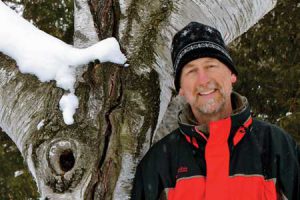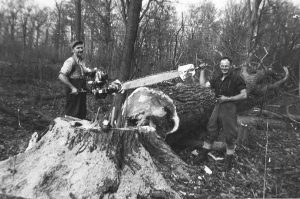
By Neale McDevitt
Ask 20 different people to define the Morgan Arboretum and you’re likely to get 20 vastly different answers.
Birdwatchers will say the Arboretum, located in Ste-Anne-de-Bellevue on the westernmost tip of the Island of Montreal, is a sanctuary to some 170 species of migratory and wintering birds. Arborists will tell you it is a 245-hectare forested Eden – some 45 hectares larger than Mount Royal Park – containing examples of most of Quebec’s native trees, as well as 18 collections of trees and shrubs from around the world. Outdoor enthusiasts will rave about the Arboretum’s network of hiking, snowshoeing and cross-country ski trails. Astronomers claim, as the darkest spot on the island, it provides the best place to star gaze. Dog walkers will tell you it is the most picturesque dog run on the Island. And children will talk excitedly about the tobogganing, the exploring, the sugaring off, the frog ponds and, of course, the squadrons of chickadees that eat right out of your hand.
“The Arboretum is many things to many people,” said Jim Fyles, Academic Director of the Arboretum and a professor in the Department of

Natural Resources Sciences. “It’s what makes my job so interesting because every decision we make can impact a whole lot of people.”
The Morgan Arboretum is owned and managed by McGill in collaboration with the Morgan Arboretum Association, a registered charity that provides funding, and the Friends of the Morgan Arboretum who volunteer their time to work on projects and provide advice about management.
Ecosystem balance
Like all healthy woodlands, the Arboretum’s many disparate parts are entirely interconnected and interdependent – often in ways that are too subtle for the untrained to recognize.
“Every spring, we get out here with a group of volunteers to help clean up from the winter and inevitably, someone says ‘Let’s get rid of those old fallen trees over there,’” said Fyles. “They don’t realize that we’re a real hot spot for newts and salamanders and they love hanging out under these old logs. One major difference between a park and a woodland is what you do with the dead wood.”
But a harmonious balance isn’t always easy to maintain, as different groups lobby for their areas of interest – often without fully understanding the complexity of the relationships at work.
More than one well-meaning conservationist has voiced concerns about dogs, and even children, tramping through the forests.

While he acknowledges dogs can be a thorny issue at times, Fyles points out that they contribute to the Arboretum in ways that few people understand. “In a couple of months, this place will be full of trilliums – beautiful flowers that are rapidly disappearing elsewhere in Quebec in part because of an increasing deer population that likes to snack on them,” said Fyles. “But trilliums do well here. Is it because the presence of dogs keeps the deer somewhat at bay? It’s a really intriguing management issue.
“And kids? Kids are supposed to be looking under rocks and collecting leaves and acorns,” Fyles continued. “It’s a great place for them to learn something while they have fun.”
Open-air education
“Living classroom” is yet another, definition of this West Island treasure. Fyles estimates that close to 3,000 McGill and John Abbott College students spend time in the Arboretum as part of their studies in everything from invertebrates to St. Lawrence ecosystems.
“It is a fantastic arrangement because, in my forest ecology course I can give a lecture on Monday and on Thursday we spend three hours in the Arboretum seeing exactly what I was talking about,” he said.
This open-air classroom isn’t reserved solely for university and CEGEP students. The Arboretum runs an extensive public outreach program that brings elementary and secondary school students to the grounds for important educational experiences. “This is where it starts for a lot of children,” said Fyles. “They come here, learn a bit about the environment and, next thing you know, they start asking questions about issues like climate change, sustainability and biodiversity.”
But there is something else at work in the Arboretum, something beyond these formative lessons in biology and ecology. In an increasingly disconnected world, urbanites have fewer and fewer opportunities to connect with nature.
Ask anyone who has skied its trails, hiked its paths or just sat in the sun and listened to bird song and they will tell you of the restorative powers of the Arboretum, of its innate ability to revive tired minds and revitalize spirits sagging beneath the weight of the workaday crush.

“There is a relationship with green spaces that hasn’t been captured at all [by academics],” said Fyles.
“Look at the chickadees – there is nothing quite like feeding the chickadees. You hold out a handful of seeds and they land on your fingers with those little feet that don’t weigh anything at all – everyone just sort of lights up,” he said with a smile. “What is that? Why does it lift us like that? What is it about this simple interaction that touches us so profoundly?
“If all we’re saying is ‘we’ve got so many cubic metres of wood over here’ then we’re missing out on the Arboretum’s most wonderful quality. Yes, it can teach us a great many things, but the Arboretum also rejuvenates us and reminds us that we are privileged to be part of the natural world.”
All in the family: Watson family roots deep in Arboretum soil

No one has a more intimate relationship with the Morgan Arboretum than John Watson, Forest Operations Manager. Watson, whose father Bob built the Arboretum and oversaw its operation for 31 years, was born on the grounds in the foreman’s house, giving him a unique from-birthplace-to-workplace trajectory.
“I never wanted to work here,” said Watson, who is also the longstanding coach of the University’s lumberjack team. “I was supposed to be a hockey player but I got hurt. My father nabbed me and said, ‘OK, you’re going to be my apprentice.’”
Following a two-year stay in Guelph (the first time he had ever lived outside Ste-Anne-de-Bellevue) to study aboriculture, the younger Watson returned to learn by his father’s side. When Bob Watson retired in 1976, John took over operations.
“I do all the work that no one else wants to do,” said the straight-shooting Watson with a laugh. “I’m in charge of production [the Arboretum sells limited quantities of firewood and maple syrup] and I maintain and protect our collection. I groom the ski trails, keep the roads open – basically all the physical aspects of the Arboretum.”
When asked how the Arboretum has changed over the years, Watson singles out work methods and technology. “I am amazed at what my father accomplished with the resources he had when he started this. No chainsaws – just horses and plows. He cleared out hundreds of acres to plant the collection and plantation. I honestly don’t understand how he did it,” said Watson
“Of course, my father took all the credit, but my mother was backbone of the Arboretum. I was born in April and she planted 350 trees in May. She was quite a lady.”
Despite his lifelong ties to the Arboretum, Watson isn’t one to wax overly poetic about his unique workplace. Where visitors see an oasis of tranquility, Watson sees a long To Do list.
“When I come in here I look for the bad things, the stuff that has to be done, the work part of it,” he said. “When you are in a place for 12-14 hours a day it’s like a kid who eats chocolate every day – you know it’s good but you don’t really appreciate it as much as you should.”
– Neale McDevitt
